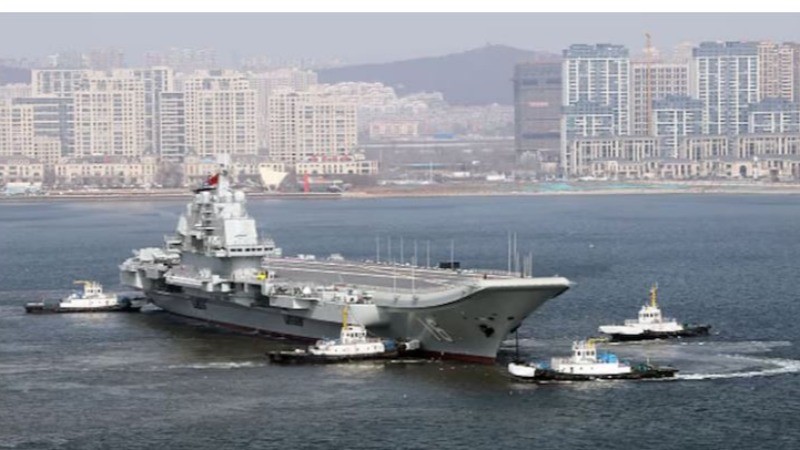
China's Aircraft Carriers Deploy Near Japan and Taiwan: Rising Tensions in the Region: For the first time, the Chinese People's Liberation Army Navy (PLAN) has deployed all three of its aircraft carriers simultaneously, marking a significant display of naval strength. This development coincides with the 12th anniversary of China’s first aircraft carrier, Liaoning, which was commissioned in 2012 and has since undergone extensive upgrades and training exercises. Recently, Liaoning has been spotted near Taiwan and Japan, raising concerns among regional powers.
Liaoning's Activities in the Pacific
Liaoning, classified as Type 001, has been conducting routine exercises in the West Pacific aimed at enhancing its combat capabilities. A spokesperson for the Chinese Ministry of National Defense confirmed that these drills are regular and intended to maintain readiness. Japan’s Ministry of Defense has reported that Liaoning, along with a Carrier Battle Group (CBG), was detected north of Taiwan in Japan's exclusive economic zone. This group was observed sailing from the East China Sea towards the Philippine Sea, passing between the Yonaguni and Iriomote islands.
Japanese officials have labeled this deployment as provocative, noting it was the first instance of Chinese warships entering Japan's contiguous waters, calling the action "completely unacceptable." The carrier group also performed multiple operations involving fighter jets and helicopters near the Miyako Islands, a strategic area for U.S. military operations in the Pacific, heightening concerns about security in the region.
Shandong's Role in Military Exercises
China's second aircraft carrier, Shandong, has also been active recently. Operating primarily in the South China Sea, Shandong participated in nighttime certification tests for fighter jet pilots. These exercises are part of China’s efforts to boost combat readiness and enhance operational capabilities.
Shandong plays a critical role in China’s strategy to assert control over vital maritime areas in the South China Sea, a region embroiled in territorial disputes with countries like the Philippines, Vietnam, and Malaysia.
Fujian's Advanced Capabilities
China’s third and most advanced aircraft carrier, Fujian (Type 003), recently completed its fourth sea trial, which began on September 3. The trials included tests for replenishing supplies at sea and demonstrated Fujian’s capabilities, such as its cutting-edge Electromagnetic Aircraft Launch System (EMALS). This advanced technology allows for smoother and more efficient takeoffs of heavier fighter jets, positioning Fujian among the world's most sophisticated aircraft carriers. Reports indicate that China is also in the process of constructing a fourth, nuclear-powered aircraft carrier.
Rising Military Presence Around Taiwan
As China’s naval power expands, so does its military presence near Taiwan. Taiwan's defense ministry reported a significant uptick in Chinese military activity in the region. Recently, 29 Chinese aircraft were detected engaged in a "joint combat readiness patrol" alongside Chinese warships. The day before, 43 Chinese military aircraft were noted around Taiwan, although none entered Taiwanese airspace.
Taiwan's defense ministry has warned of the escalating threat posed by China’s military buildup, describing it as a “serious challenge” to neighboring countries. The ministry noted that while China is increasing its military activities, it is also engaging in diplomatic discussions with the United States, suggesting a dual strategy of intimidation and negotiation.
Strategic Drills Simulating Potential Conflicts
Sources familiar with the situation indicated that China’s military activities are part of annual drills aimed at simulating possible conflicts in the region. These exercises include simulated attacks in the Taiwan Strait and the South China Sea, focusing on strategies to prevent foreign assistance during conflicts. Chinese air force drills have also aimed to achieve "air dominance" off Taiwan's southwestern coast, including practicing air refueling near the Bashi Channel.
These maneuvers are part of a broader Chinese strategy to deter foreign intervention, particularly from the United States, in any potential conflict regarding Taiwan or other regional issues. Reports suggest that China's expanding naval capabilities are intended to delay or prevent U.S. forces from responding in the event of military conflict.
China’s Regional Strategy and International Relations
China’s recent military activities around Taiwan are indicative of a larger geopolitical strategy. Taiwan, which China claims as part of its territory, has experienced increasing military pressure from Beijing over the past five years. The recent surge in activity aligns with diplomatic visits by Chinese officials to the United States, complicating the security landscape in the region.
Taiwan's government has firmly rejected China’s claims of sovereignty, asserting that only its people can determine the island's future. As tensions escalate, China’s advancements in naval capabilities and military exercises reflect its intent to strengthen control over the region, while neighboring countries and the United States remain vigilant.